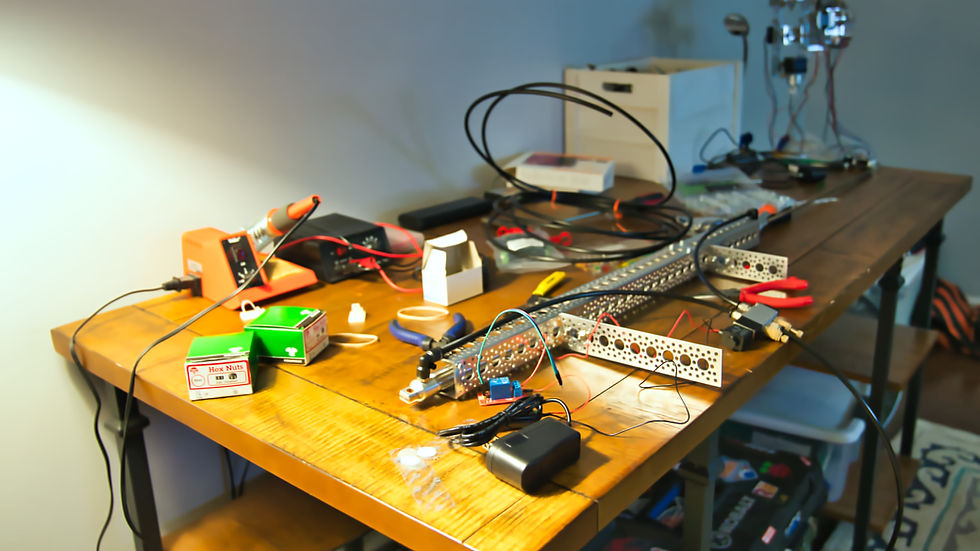Maximizing Battery Life in IoT Devices: A Guide to Power Efficiency
- Eurth Engineering
- Jul 15
- 5 min read
Updated: Oct 10
In the connected era of smart infrastructure solutions and AI-powered embedded systems, one principle remains constant.
A brilliant IoT device is only as good as its battery life.
From smart poles lighting city streets to soil sensors in precision agriculture, power efficiency isn’t just an engineering metric—it’s the foundation of reliable, scalable, and sustainable IoT product engineering. Miss it, and you risk field failures, costly service calls, and broken customer trust.
At EurthTech, we’ve engineered and deployed battery-powered embedded IoT systems across smart cities, industrial automation, and environmental monitoring. Here’s what we’ve learned about designing for longevity in the real world.
The Real Power Challenge: Theory vs. Field
On paper, power estimates look promising. A 2400mAh battery, 10µA sleep current, and radio bursts every 30 minutes—sounds like two years of life, right? But when we deployed a field tracker designed for a 12-month cycle, devices began dying in less than five months.On paper, your power budget looks perfect—2400 mAh battery, 10 µA sleep current, radio bursts every 30 minutes—two years of life, right?In field deployment, those same devices often fail months earlier.
In one of our smart pole IoT integrations, a tracker designed for 12 months of uptime started dying in 5 months. Postmortem diagnostics revealed:
High self-discharge in extreme temperature zones
Inefficient LDO regulator wasting 50% of available energy
Frequent wake-ups triggered by motion noise
That’s when we shifted focus—from component-level optimization to system-level energy budgeting

System-Level Power Budgeting: Think Holistically
The first rule of power design: everything consumes energy—even when “off.”
At EurthTech, we profile each subsystem—hardware and software—across active, sleep, and transition states.
Subsystem | Examples | Design Considerations |
MCU | Cortex-M series, RISC-V, ESP32 | Sleep/active current, wake-up time, clock scaling |
Sensors | IMU, temperature, soil moisture | Sampling rate, warm-up time, interrupt-based triggering |
Wireless Module | BLE, LoRa, Wi-Fi | TX/RX current, duty cycle, retries, handshake overhead |
PMIC & Regulators | LDO, Buck, Buck-Boost | Quiescent current, efficiency under variable load |
Leakage Paths | GPIO pull-ups, diodes, LEDs | Peripheral shutdown, pin states, reverse current protection |
Pro Tip: Tools like Joulescope and Nordic Power Profiler Kit II help visualize microamp-level consumption during real workloads.
Voltage Regulation: The Silent Killer
Voltage mismatches and inefficient regulators can silently drain your energy reserves. We’ve seen up to 50% power loss due to poor voltage conversion.
Regulator Type | Ideal For | Efficiency Range |
LDO | Very low current, small voltage delta | 50–70% |
Buck Converter | High current, large step-down | 85–95% |
Buck-Boost | Battery voltage swings across thresholds | 75–90% |
Example: powering 1.8 V @ 20 mA from a 3.6 V battery via LDO yields < 60% efficiency.Switching to a buck converter doubled run-time in our smart agriculture sensors.
Always check quiescent current—even “idle” regulators can consume 10 µA or more, cutting months off battery life.

Communication Optimization: Less is More
Your wireless module often dominates power consumption. The key to efficiency isn’t just which protocol you choose—but how often and how much data you transmit.
Protocol | Best Use Case | Power Characteristics |
Wi-Fi | High-bandwidth bursts | High current, short-duration |
BLE | Proximity, wearables | Very low power, short-range |
LoRa / Sub-GHz | Remote sensing, long-range | Long TX time, low average current |
NB-IoT / LTE-M | Asset tracking, urban IoT | Medium power, useful for infrequent sync |
Case Study:
In our smart irrigation controller, initial 5-minute soil updates drained batteries fast.
After introducing edge AI logic, devices transmitted only when threshold breaches occurred—reducing transmissions by 80% and tripling battery life.
Firmware as the Frontline of Efficiency
Firmware is where embedded intelligence meets energy efficiency. Even ultra-low-power MCUs fail if the firmware keeps them awake unnecessarily.
Our EurthTech firmware checklist for IoT & embedded systems:
Deep Sleep Modes: Use the lowest available states between tasks.
Interrupt-Driven Wakeups: Prefer sensors/RTCs over constant polling.
Peripheral Shutdown: Disable UART, ADC, or I²C when unused.
Duty Cycling: Schedule sensing and communication intelligently.
Dynamic Clock Scaling: Adjust CPU frequency to task load.
We also embed telemetry to measure:
Wake-up counts
Average active duration
Sleep-to-active ratio
This digital twin-style feedback bridges lab testing and real-world behavior.

Battery Chemistry: Not All Cells Are Equal
Battery life depends as much on chemistry as on capacity. Consider temperature tolerance, discharge curve, and peak current handling.
Chemistry | Best Use Case | Notes |
Li-ion / Li-Po | Rechargeable wearables | High energy density, limited cold tolerance |
Li-SOCl₂ | Industrial long-life sensors | Very low self-discharge, but non-rechargeable |
NiMH | Cost-sensitive, cyclic usage | Good for consumer-grade sensors, moderate energy density |
Key evaluation factors:
Can it handle radio peak loads (100–300 mA)?
Will it survive −20 °C winters?
Can you predict degradation for proactive replacement?
Environmental Testing: Beyond the Bench
Bench numbers mean little until you’ve tested in the field. For IoT and smart city devices, we validate under real-world conditions:
Thermal Drift: Measure sleep current at −20 °C to +60 °C
Ingress Protection: Detect water and dust leakage on PCBs
Load Simulation: Replicate live sensor duty cycles
Power Telemetry: Correlate firmware events with consumption spikes
This field-driven engineering ensures stability before large-scale rollout in municipal or industrial deployments.

Designing for Predictability and Serviceability
Even the most efficient embedded design will one day lose charge. The difference between a product failure and a smart recovery lies in foresight.
Low Battery Alerts: Cloud alarms for proactive maintenance
Replaceable or Rechargeable Options: Simplify servicing in smart poles or field sensors
Remote Tuning: OTA control to modify sensing intervals
AI-based Predictive Maintenance: Use runtime data to forecast replacements before failure
Firmware OTA updates have yielded 20–30% energy gains in our field deployments through real-time optimization.
AI and Edge Intelligence in Power Management
The next evolution of embedded systems development lies at the intersection of AI and IoT.By integrating Edge AI models directly into devices, we enable smart decision-making—only waking the radio or sensors when necessary.
Applications include:
AI-based smart lighting systems that adjust brightness based on pedestrian detection
Smart poles with AI integration for adaptive energy control
Predictive maintenance using AI + IoT telemetry
AI-enabled geospatial analytics (GeoAI) for infrastructure monitoring
This is how AI for smart infrastructure transforms devices from passive to predictive.
Final Thoughts: Every Microamp Matters
Building battery-efficient embedded IoT systems is both an art and a science. It demands an understanding of:
How regulators behave across variable loads
How radios retry during weak connectivity
How firmware silently wakes when nobody’s watching
At EurthTech, we engineer AI-powered, IoT-enabled smart infrastructure solutions that last years in the field—whether they’re powering smart lighting systems, AI GIS analytics, or edge AI embedded devices.
When every microamp matters, design intelligently, code efficiently, and think system-wide.
💡 Ready to build zero-maintenance smart IoT systems?
📞 Connect with EurthTech’s engineering team for a Power Profiling & AI Optimization Session before your next smart city deployment.










Comments